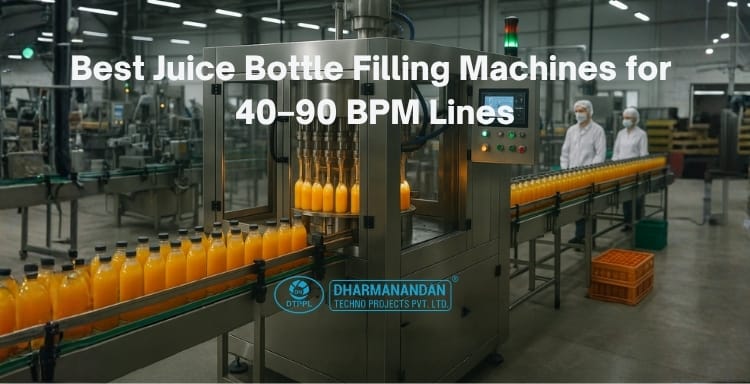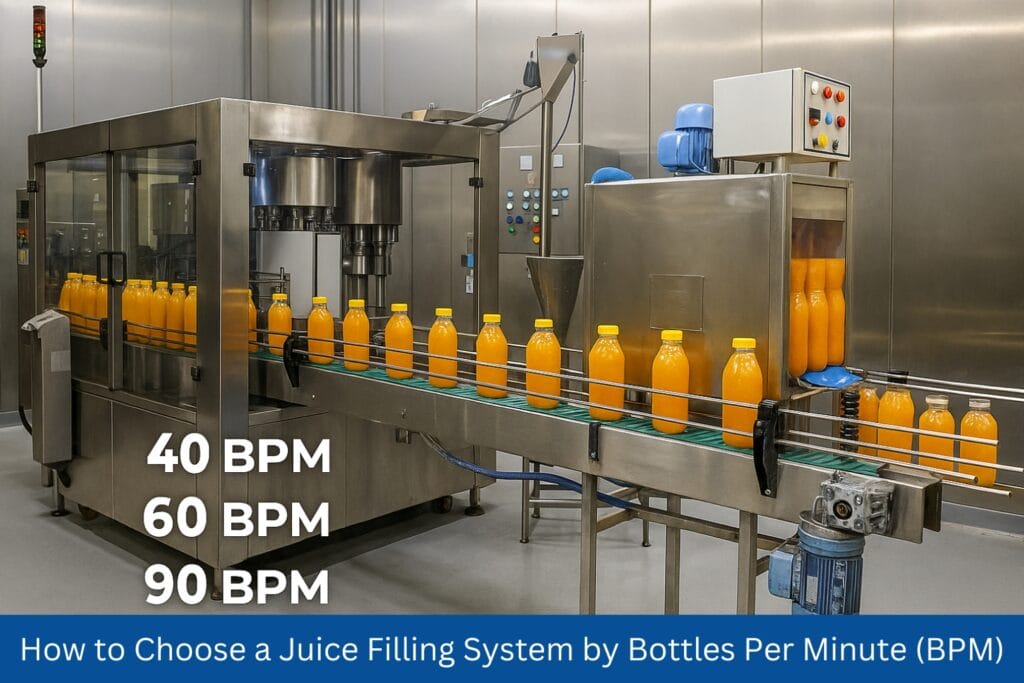
Table of Contents
40BPM to 90BPM Juice Bottle Filling Machine: How to Select?
October 28, 2025
Objective:
Provide a clear, technical and easy-to-apply method for selecting a Juice Bottle Filling Machine in the 40-90 BPM range. Explain how to align target throughput with container format, product type (clear juice vs. juice with pulp), filling technology, temperature regime (ambient vs. hot-fill), clean-in-place (CIP) needs and downstream integration (capping, labeling, packing). Include practical sizing rules, line-layout notes and a price/ROI framework relevant to a small-to-mid Juice Plant or fruit juice plant.
Introduction
Choosing a 40–90 bottles-per-minute Juice Filling Machine is not just a speed decision. The right selection depends on product rheology (clarified juice vs. pulpy), fill temperature (ambient, warm or hot-fill), bottle material (PET or glass), changeover complexity (SKUs, volumes) and how the filler integrates with the juice bottle packing machine, capper, labeler and end-of-line equipment. A well-matched machine can stabilize accuracy, reduce spillage, cut downtime and maintain sanitary conditions – with capacity that matches real-world Overall Equipment Effectiveness (OEE), not just a catalog BPM.
This guide walks through the key decisions with an emphasis on 40, 60 and 90 BPM configurations, so you can translate sales forecasts into a stable, scalable Juice Plant design.
What a Juice Bottle Filling Machine Does
A modern rotary or linear Juice Bottle Filling Machine typically combines:
- Infeed & bottle handling: Air conveyor or table, star-wheels, neck support (common for PET) or base conveyance (glass).
- Rinsing/sterilizing: Invert-and-rinse or ionized-air rinse for dry clean.
- Filling: Valve type chosen to match juice type and temperature.
- Capping: Torque-controlled screw caps (PET) or crown/twist caps (glass).
- Outfeed to the juice bottle packing machine: Accumulation, labeler, coder, case packer, palletizer.
The filler’s valve technology largely governs speed, fill accuracy, cleanup time and product compatibility.
Read Our Article: Auto Bottling Plant for Juice & Beverages: A Comprehensive Guide
Juice Filling Technologies and When to Use Them
1. Gravity / Level Fill
- Use: Low-viscosity, clear juices without pulp; ambient or warm fill.
- Pros: Simple, cost-effective, easy CIP.
- Notes: Level-controlled valves make consistent visual fill heights.
- Hot-Fill
- Use: Shelf-stable juices that rely on hot-fill/hold/cool instead of tunnel pasteurization.
- Pros: Extended shelf life without cold chain.
- Notes: Requires heat-set PET bottles, precise temperature control and a compatible monoblock design.
- Volumetric (Piston / Flowmeter / Servo-Mass/ Magnetic)
- Use: Juices with pulp, higher viscosity blends or premium accuracy targets.
- Pros: Dose-by-volume improves accuracy across SKUs; handles particulates better than gravity.
- Notes: Flowmeter systems (mass or magnetic) provide fast recipe changeover; piston systems handle thicker or pulpy products well.
4. Isobaric / Counter-Pressure (Less common for still juice)
- Use: Carbonated or nitrogen-dosed beverages; not typical for still juice lines.
Juice Bottling Plant: Type, Size and Handling
- Bottle material:
- PET is common; hot-fill requires heat-set PET with paneling for volume change during cooling.
- Glass is heavier, heat tolerant, but needs base-conveyed handling and different cappers.
- Bottle sizes & neck finishes:
- 200–500 mL run faster than 1 L; neck support stars simplify PET handling.
- Each neck finish needs matching change parts (stars, guides, capping heads).
- Changeover:
- More SKUs may push toward 60 BPM instead of 40 BPM to maintain daily output after frequent changeovers.
- Fast-change star-wheels and recipe memory can cut downtime.

Key Features to Look for in a Modern Juice Filling Machine
- Hygienic design
- Sloped surfaces, minimal dead-legs, sanitary valves, tool-less disassembly where needed.
- CIP capability
- Validated CIP cycles (temperature, flow, chemical) and well-designed spray-balls or clean ports.
- Temperature management (for hot-fill)
- Product path insulation, temperature hold time control and cooled capping zones when required.
- Accurate dosing and low spillage
- Volumetric or level systems tuned to juice type keep giveaway low and line clean.
- Automation & HMI
- Stored recipes (bottle, fill volume, temperature), fault diagnostics, OEE dashboards.
- Quick-change parts
- Color-coded stars, adjustable guides and capping head tools for fast SKU swaps.
- Integration readiness
- Electrical and mechanical interfaces to the juice bottle packing machine, labeler, coder and case packer.
- Safety & compliance
- Guards, interlocks, e-stops and regional electrical compliance suited to your plant location.
Integration with Capping, Labeling and Packing
A 40–90 BPM filler must match downstream capacity:
- Capper: Torque control with cap presence detection and reject; compatible chucks for each closure.
- Labeler: Pressure-sensitive or hot-melt wrap; ensure labeler throughput exceeds filler BPM to absorb micro-stops.
- Coding/Inspection: Date-coder, neck or body check, fill-height inspection (for level fill) and cap integrity checks.
- juice bottle packing machine: Tray packers, wrap-around case packers or shrink bundlers must be rated above your filler to avoid back-pressure.
Tip: Design accumulation between filler and labeler/packer to decouple minor stoppages.
Juice Filling Machine: Reducing Wastage and Downtime
- Valve choice: Volumetric reduces overfill giveaway; gravity is simpler for clear juices.
- Drip control: No-drip or cut-off features keep conveyors clean and reduce rework.
- Sanitation planning: Schedule CIP during shift changes or label roll swaps when possible.
- Spare parts: Keep seals, springs and wear parts on hand to avoid long stops.

How to Select Juice Filling by Production Capacity (40 / 60 / 90 BPM)
40 BPM (Small lines or single-SKU runs)
- Best for: Startup fruit juice plant, short runs, limited SKUs, lower daily volumes.
- Typical tech: Linear gravity for clear juice; compact rotary for hot-fill small PET.
60 BPM (Balanced throughput with flexibility)
- Best for: Multi-SKU producers with frequent changeovers; moderate daily demand.
- Typical tech: Rotary level fill for clear; volumetric (flowmeter) for pulpy juices.
90 BPM (Higher volume and SKU variety)
- Best for: Larger regional brands; multiple SKUs with hot-fill capability.
- Typical tech: Rotary hot-fill monoblock (rinse–fill–cap), servo flowmeter or high-speed gravity depending on product.
Juice Bottle Filling Machine Price Guide
Prices vary by:
- Configuration: Linear vs. rotary; monoblock (rinse–fill–cap) costs more but saves footprint and labor.
- Filling technology: Flowmeter or piston systems cost more than gravity but improve accuracy and SKU range.
- Hot-fill readiness: Heat-set handling, temperature control and materials rated for hot paths add cost.
- Automation: Recipe memory, servo axes and integrated inspection raise price and reduce downtime.
- Change parts: The more bottle/cap formats, the more parts and tooling required.
- Materials and build: Higher-grade stainless, sanitary design and validated CIP systems add value.
- Imported vs. locally built: Lead time, service response and spares availability may influence total cost of ownership. Evaluate lifecycle costs, not just purchase price.
How to Calculate ROI (Simple Model)
- Annual savings = (Labor saved + Reduced giveaway + Reduced downtime losses) – (Added utilities/consumables)
- Payback (years) = Total investment ÷ Annual savings
- NPV/IRR (optional): Consider 3–5 year horizon with maintenance and parts.
Quick win contributors: Accurate dosing (less product giveaway), shorter changeovers, fewer rejects, faster restarts after stops.
Common Mistakes for Juice Filling Plant and How to Avoid Them
- Choosing gravity for pulpy products → Use volumetric (piston/flowmeter) for particulates.
- Under-rated downstream equipment → Labeler and packer must exceed filler speed to buffer micro-stops.
- Ignoring hot-fill requirements → If hot-fill is planned, specify heat-set PET handling and temperature controls from day one.
Neglecting sanitation → Design CIP paths, chemical compatibility and validation up front.
Conclusion
Selecting a Juice Bottle Filling Machine in the 40–90 BPM range is a system decision. Start with demand and realistic OEE, then align product type with filling technology (gravity for clear, volumetric for pulpy, hot-fill-ready for shelf-stable lines). Choose bottle handling that fits PET or glass, plan changeovers with quick-change parts and stored recipes and size the juice bottle packing machine and labeler above filler speed. With a disciplined approach, your juice plant can achieve stable throughput, accurate fills, clean operation and predictable ROI – whether you land on 40BPM, 60BPM or 90BPM as the right fit today, with room to grow tomorrow.
About Author

Director – Global Marketing and Sales
Mr. Bhavesh from Dharmanandan Techno Projects Pvt. Ltd. has played a pivotal role in elevating the DTPPL brand to the global stage, leveraging his exceptional expertise in marketing and communications. He is committed to helping clients achieve significant growth while strengthening their own brands. Dharmanandan Techno Projects Pvt. Ltd. is a leading manufacturer and supplier of water purification systems and turnkey solutions for mineral water plants. With years of experience in designing and delivering high-quality water treatment solutions, the company provides end-to-end services, including system design, installation, maintenance, and ongoing support. Specializing in scalable and customizable water plants, DTPPL has successfully served industries worldwide, ensuring clean and safe drinking water across diverse applications.




